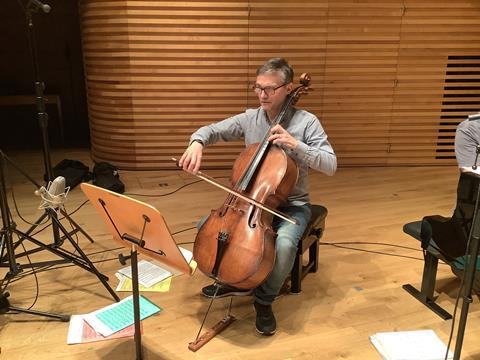Adrian Bradbury explores how the cellist Beatrice Harrison took inspiration from the German school of cello playing, particularly in regards to her bowing technique, and how this gave her the edge over her English contemporary players

Discover more Featured Stories like this in The Strad Playing Hub
On 31 January 1907 cellist Beatrice Harrison, just turned 14 and a pupil of W. E. Whitehouse at the Royal College of Music in London, played to visiting soloist Hugo Becker, the ’handsome Strasbourgian who’ - according to Henry Wood - ’knew the Brahms tradition probably as no one else in the world did.’ ’He was very pleased,’ Beatrice wrote in her diary, noting also that on 2 Feb she went to hear him in a Philharmonic Concert: ’He played awfully well and the orchestra was too exquisite.’
Meanwhile, again according to her diary, ’On 29th May [1907] I am making my début as a cellist at the Queen’s Hall under the conductorship of Mr Henry J. Wood. I am playing the Saint-Saëns Concerto, the suite of Victor Herbert, the Boëllmann Variations and also Bach for encores. I do hope it will go well.’ And, by her subsequent account, so it did: ’Everything went off awfully well. Everybody was pleased. Had 20 bouquets. Mr Wood was very pleased. The Times critic said I was a musician through and through.’
With this ‘junior début’ under her belt, she embarked on her next phase of instruction, travelling in 1908 to Frankfurt to study with Becker for the next couple of years, following him to Berlin when he took a professorship there in 1909 and to Lake Como where he had a holiday villa in the same village as his own beloved late teacher Alfredo Piatti. Having won the Mendelssohn Prize - the youngest competitor and first cellist ever to do so - and played the Dvořák concerto with Becker conducting in December 1910, Beatrice returned to England after a short European tour and made her ‘adult début’, again at the Queen’s Hall under Henry Wood, on 16 June 1911, playing the Haydn D major, the Dvorak and the Tchaikovsky Rococo Variations. This time The Times critic was adulatory: ’Her playing was intensely enjoyable because of the presence of this undefinable quality in her playing, a peculiar clarity of tone and phrasing which can only be called eloquence.’
’Her playing was intensely enjoyable because of the presence of this undefinable quality in her playing, a peculiar clarity of tone and phrasing which can only be called eloquence’
What exactly did she learn from Becker that transformed her into arguably the greatest British cellist of her generation, Elgar’s favourite for recording and performing his concerto and the dedicatee of works by Delius, Bax, Ireland, Quilter, Cyril Scott, Stanford, Herbert Hughes, York Bowen and more?
A major clue may be found in a letter to Beatrice’s sister May from their mother Annie Harrison. In the Spring of 1910 Beatrice was taking lessons from Becker at Tremezzo on Lake Como with her mother in constant attendance, while her sister May - an equally important violinist - was studying with Leopold Auer in St Petersburg. Mrs Harrison, perhaps guilty that she attending to one daughter and not the other, wrote the letter: ’My darling May, Baba [Beatrice] had a marvellous lesson from Becker today and I find he works all his splendid variety of tone by working up and down the fingerboard to the bridge, simply marvellous […] I think Becker gets the effect of almost breathing as it were on a note, by putting his bow down on fingerboard and then working gradually towards bridge. It is just like a voice, try it and also in dim. passages, the more quietness when the sound commences or when it ceases the better. It sort of leaves you with your mouth wide open and a sigh, it is wonderful. Baba is getting it in the cadenza of the [Rococo] Variations. You sort of open your vocal cords and let the sound gradually out, Becker treats his instrument exactly like a voice.’
It strikes me that Beatrice was learning to develop that dimension of bowing technique the German school of playing teaches so effectively: exploring the bridge. By adding the richer and more guttural hue of vowels and consonants afforded by moving her bow’s contact point just that extra half inch bridge-wards, Beatrice was Germanifying her expressive palette. Perhaps it’s no coincidence that the Frankfurt Group of composers - especially Grainger, Quilter and Cyril Scott - were then so drawn to her as an interpreter, for they too were English speakers who had been to the same Frankfurt Conservatoire as Beatrice, Dr. Hoch’s Konservatorium, some ten years earlier and where they received rigorous training from Leipzig-trained composer Iwan Knorr. And it’s notable that Beatrice’s two most distinguished champions, Elgar and Delius, both had German-trained violin teachers: Elgar’s was Adolf Pollitzer, a Joseph Böhm pupil, and Delius’s the German-born Manchester immigrant William Bauerkeller.

Tempting though it is to characterise Beatrice’s playing through her left hand portamenti and the freedom of her rubato (Arnold Bax said ’I know she must be kept in order about rubatos, but I do believe she puts the stuff over better than any English cellist’), movements in time and space that are immediately arresting and obvious, I would contend that her special quality, the ’eloquence’ referred to by The Times critic following her return from Germany, is to be found in that much more subtle dimension, one that distinguishes a master from an expert: absolute expressive control from sul tasto to sul ponticello.
‘The Pre-Raphaelite Cello’ (Adrian Bradbury, cello and Andrew West, piano), a CD of music associated with Beatrice Harrison by Percy Grainger, Roger Quilter and Cyril Scott, is released by SOMM Recordings on 17 May: https://listn.fm/preraphaelitecello/
‘The Cello and the Nightingale’, a documentary about Beatrice Harrison presented by Kate Kennedy, is on Radio 3 at 19.15 on 19 May
‘The Cello and the Nightingales’, a new edition of Beatrice Harrison’s autobiography edited by Patricia Cleveland-Peck, is published by Canongate on 9 May
Read: Opera is key to string playing - Adrian Bradbury
Read: Geminiani’s scales: a portal to the past
Discover more Featured Stories like this in The Strad Playing Hub
The number one source for playing and teaching books, guides, CDs, calendars and back issues of the magazine.
In The Best of Technique you’ll discover the top playing tips of the world’s leading string players and teachers. It’s packed full of exercises for students, plus examples from the standard repertoire to show you how to integrate the technique into your playing.
The Strad’s Masterclass series brings together the finest string players with some of the greatest string works ever written. Always one of our most popular sections, Masterclass has been an invaluable aid to aspiring soloists, chamber musicians and string teachers since the 1990s.
American collector David L. Fulton amassed one of the 20th century’s finest collections of stringed instruments. This year’s calendar pays tribute to some of these priceless treasures, including Yehudi Menuhin’s celebrated ‘Lord Wilton’ Guarneri, the Carlo Bergonzi once played by Fritz Kreisler, and four instruments by Antonio Stradivari.












































No comments yet